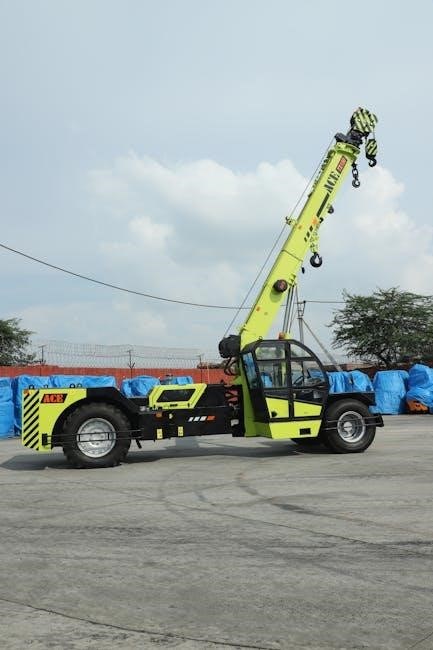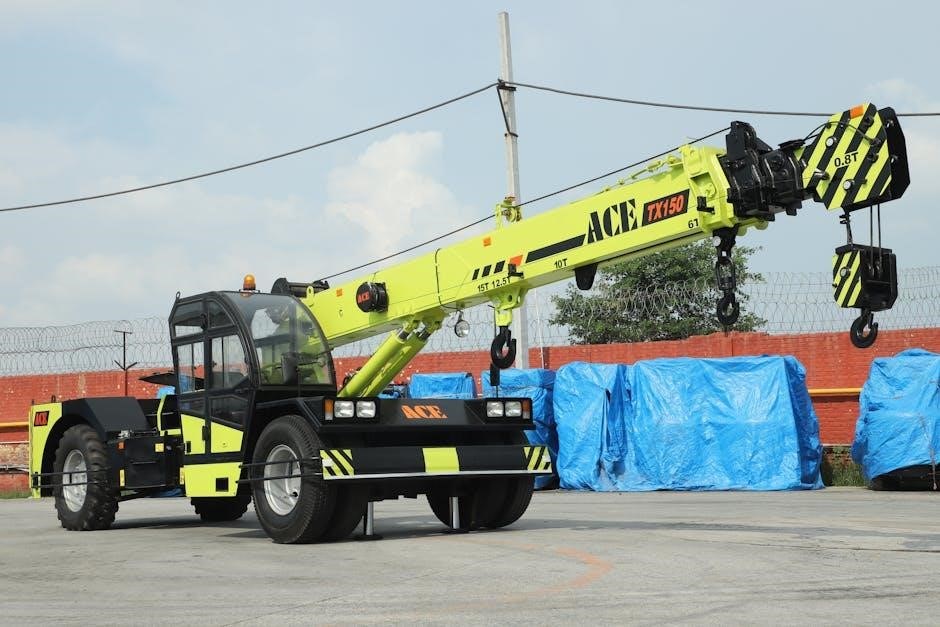Vehicle lifting points are essential for safe and effective vehicle lifting. They are specifically designed locations on a vehicle’s frame, axle, or suspension to support the weight during lifting, ensuring stability and preventing damage. Using the correct lifting points is crucial to avoid accidents and maintain vehicle integrity. This guide provides detailed information on identifying and using these points safely, helping professionals and DIYers alike to lift vehicles with confidence and precision.
1.1 What Are Vehicle Lifting Points?
Vehicle lifting points are specifically designed locations on a car, truck, or SUV’s frame, axle, or suspension. These points are engineered to safely support the vehicle’s weight when lifted, ensuring stability and preventing damage. They are typically reinforced to withstand the stress of lifting and are identified in manufacturer guidelines or service manuals. Lifting points are crucial for avoiding structural damage and ensuring safety during maintenance or repairs. They are often marked or described in detail in a vehicle lifting points guide PDF, making it easier for users to locate and use them correctly.
1.2 Importance of Using Correct Lifting Points
Using correct lifting points is vital for safety and preventing vehicle damage. Incorrect lifting can cause structural damage, axle misalignment, or even accidents. Proper lifting points distribute weight evenly, ensuring stability and protecting the vehicle’s frame. Manufacturer guidelines and a vehicle lifting points guide PDF provide precise locations to avoid risks. Ignoring these points can lead to costly repairs or safety hazards. Always refer to the guide to ensure accurate lifting practices and maintain vehicle integrity during maintenance or repairs.
1.3 Purpose of a Vehicle Lifting Points Guide
A vehicle lifting points guide serves as an essential resource for identifying and using the correct lifting points on any vehicle. Its purpose is to provide clear, accurate information to ensure safe and damage-free lifting. The guide helps users locate manufacturer-recommended lifting points, understand proper techniques, and avoid common mistakes. It is designed to be user-friendly, covering various vehicle types and models. By following the guide, professionals and DIYers can lift vehicles with confidence, adhering to safety standards and preventing potential damage. This comprehensive tool is indispensable for anyone working with vehicles, ensuring efficiency and reliability in every lifting task.

Safety Considerations When Lifting a Vehicle
Safety is paramount when lifting a vehicle to prevent accidents and injuries. Always use correct lifting equipment, ensure stability, and follow manufacturer guidelines to avoid risks and ensure a secure lift.
2.1 Why Safety Is Paramount in Vehicle Lifting
Safety is paramount in vehicle lifting due to the significant risks involved. Improper lifting can lead to vehicle instability, equipment failure, and severe injuries or fatalities. Ensuring the use of correct lifting points and equipment minimizes these risks. Additionally, adhering to safety guidelines protects the vehicle from damage and maintains a secure working environment. Neglecting safety protocols can result in legal consequences and financial loss. Therefore, prioritizing safety ensures a secure and effective lifting process, safeguarding both the operator and the vehicle.
2.2 Best Practices for Safe Lifting
Always use OEM-recommended lifting points to ensure vehicle stability and safety. Refer to the vehicle’s manual or a lifting points guide for specific locations. Employ jack stands for added security and never rely solely on a jack. Check the weight capacity of your equipment to ensure it matches the vehicle’s weight. Position the lift or jack on level, stable ground to prevent tipping. Engage the parking brake and use wheel chocks for extra precaution. Regularly inspect lifting gear for damage or wear. Following these practices minimizes risks and ensures a safe, efficient lifting process.
2.3 Common Mistakes to Avoid
One of the most critical errors is using incorrect lifting points, which can damage the vehicle or lead to accidents. Neglecting to inspect lifting equipment for damage or wear is another common mistake, compromising safety. Relying solely on a jack without stabilizing with jack stands is risky and dangerous. Forgetting to refer to the vehicle’s manual or lifting guide can result in improper lifting techniques. Additionally, failing to ensure the vehicle is on level ground or neglecting to engage the parking brake can lead to instability. Avoiding these mistakes ensures a safer and more effective lifting process.

Types of Vehicle Lifting Points
Vehicle lifting points include OEM and aftermarket options, located on frames, axles, or suspensions. They vary by vehicle type and manufacturer, ensuring safe and stable lifting.
3.1 OEM vs. Aftermarket Lifting Points
OEM lifting points are designed by the vehicle manufacturer, ensuring precision and compatibility. Aftermarket points offer flexibility and cost-effectiveness but may lack manufacturer certification. Choosing the right type depends on vehicle specifications and personal preferences.
3.2 Location of Lifting Points on Different Vehicles
Lifting points vary by vehicle type, with cars, trucks, and SUVs having distinct locations due to differences in design and weight distribution. For most vehicles, lifting points are found along the frame, axle, or suspension components. Cars typically have lifting points near the front and rear wheel wells, while trucks often have additional points along the chassis. SUVs may have reinforced frame points for added stability. Always consult a vehicle lifting points guide to identify the exact locations, as improper lifting can damage the vehicle or lead to accidents. Manufacturer-specific guides provide precise diagrams and instructions.
3.3 Frame, Axle, and Suspension Lifting Points
Frame lifting points are the most common and are typically located along the vehicle’s chassis, designed to support its weight. Axle lifting points are found near the wheels and are ideal for lighter lifts, such as tire changes. Suspension lifting points are used with care, as they distribute weight differently. Each type requires specific equipment and techniques to ensure safety and prevent damage. Always refer to a vehicle lifting points guide to determine which points are appropriate for your vehicle and lifting task. Proper usage ensures stability and avoids potential hazards during the lifting process.
How to Find Vehicle Lifting Points
Vehicle lifting points can be found using manufacturer recommendations, a vehicle lifting points guide PDF, or by locating them on the frame, axle, or suspension.
4.1 Manufacturer Recommendations
Always consult the vehicle manufacturer’s manual for specific lifting point locations and guidelines. Manufacturer recommendations ensure safety and prevent damage to the vehicle’s frame or undercarriage. Genuine parts and correct lifting techniques are emphasized to maintain structural integrity. Many manufacturers provide detailed diagrams and torque specifications for safe lifting. Adhering to these guidelines helps avoid costly repairs and ensures compliance with safety standards. Some manufacturers also offer digital guides or resources for quick reference. Following these recommendations is crucial for both professionals and DIYers to lift vehicles safely and effectively, reducing the risk of accidents or equipment failure.
4.2 Using a Vehicle Lifting Points Guide PDF
A Vehicle Lifting Points Guide PDF is an essential resource for identifying the correct lifting points on various vehicles. These guides provide detailed diagrams, specifications, and instructions to ensure safe and precise lifting. Many manufacturers and third-party providers offer these documents, which are compatible with cars, trucks, and SUVs. The guide helps users locate OEM-recommended lifting points, ensuring compliance with safety standards. By following the PDF guide, professionals and DIYers can avoid costly mistakes and ensure vehicle stability during lifting. It’s a valuable tool for anyone working with hydraulic lifts or jack stands, promoting efficiency and safety in every lifting operation.
4.3 Locating Lifting Points on Cars, Trucks, and SUVs
Locating lifting points varies across cars, trucks, and SUVs due to differences in design and weight distribution. For cars, lifting points are typically found near the front and rear wheel wells, while trucks often have reinforced frame points. SUVs may have lifting points along the axle or suspension components. Always refer to the vehicle’s manual or a guide PDF for precise locations, as incorrect lifting can cause damage. Frame-engaging lifts, like two-post lifts, require accurate alignment with OEM-recommended points. This ensures safety and prevents structural harm, making it essential to double-check before lifting any vehicle.

Choosing the Right Equipment for Lifting
Selecting the right equipment is vital for safe and efficient vehicle lifting. Two-post, four-post, and scissor lifts are popular options, while hydraulic jacks and stands provide additional support. Ensure compatibility with your vehicle type and weight capacity for optimal performance and safety.
5.1 Vehicle Lifts: Two-Post, Four-Post, and Scissor Lifts
Vehicle lifts are essential tools for safely raising cars, trucks, and SUVs. Two-post lifts are popular for their space efficiency and versatility, ideal for most garages. Four-post lifts offer greater stability and are suitable for heavier vehicles, often used in commercial settings. Scissor lifts provide a wide lifting range and are excellent for quick operations like tire changes. Each type has specific advantages, and choosing the right one depends on the vehicle’s weight, type, and the intended use. Proper installation and maintenance ensure optimal performance and safety during lifting operations.
5.2 Hydraulic Jacks and Stands
Hydraulic jacks and stands are indispensable tools for safely lifting vehicles. Hydraulic jacks provide the power needed to raise vehicles, while stands offer stable support once lifted. Always position the jack on the vehicle’s designated lifting points to avoid damage and ensure safety. Stands should be placed on level ground and rated for the vehicle’s weight. Regular maintenance of hydraulic systems is crucial to prevent malfunctions. Using these tools correctly ensures a secure lifting process, protecting both the vehicle and the person performing the lift. Always refer to the vehicle’s manual for specific instructions and guidelines.
5.3 Compatibility of Lifting Equipment with Vehicle Types
Compatibility of lifting equipment with vehicle types is crucial for safety and efficiency. Different vehicles, such as cars, trucks, and SUVs, require specific lifting tools due to variations in weight, frame design, and lifting points. Hydraulic jacks and stands must be matched to the vehicle’s weight capacity and lifting point locations. Using incompatible equipment can lead to instability, damage, or accidents. Always consult the vehicle’s manual to ensure the lifting gear is suitable for its make and model. Proper compatibility ensures a safe and effective lifting process, preventing potential risks and prolonging the lifespan of both the vehicle and the equipment.

Step-by-Step Guide to Lifting a Vehicle Safely
Lift safely by preparing the vehicle, positioning equipment, and raising it gradually. Ensure stability, use jack stands, and follow manufacturer guidelines for secure lifting practices always.
6.1 Preparing the Vehicle for Lifting
Start by ensuring the vehicle is on a level surface and apply the parking brake. Disconnect the battery to prevent accidental start-ups. Gather all necessary tools, including a hydraulic jack and jack stands. Consult the vehicle’s manual to locate the recommended lifting points. Clear the area around the vehicle to ensure safe access. Wear protective gear, such as gloves and safety glasses, to minimize risks. Double-check that all weights are evenly distributed and the vehicle is stable before proceeding. Proper preparation ensures a safe and efficient lifting process, reducing the risk of accidents or damage to the vehicle.
6.2 Positioning the Lift and Jack

Position the lift or jack at the OEM-recommended lifting points, ensuring alignment with the vehicle’s frame or axle. Refer to the vehicle’s manual or a lifting points guide for precise locations. Place jack stands nearby for added support and safety. Double-check that the lift is on a level surface and the vehicle is stable. Slowly raise the lift or jack, maintaining control throughout the process. Ensure all lifting equipment is rated for the vehicle’s weight and in good working condition. Proper positioning is critical to avoid damage and ensure a secure lift, protecting both the vehicle and the person performing the lift.
6.3 Raising the Vehicle and Securing It
Raise the vehicle slowly using a hydraulic lift or jack, ensuring the lifting points remain stable; Once lifted, immediately place jack stands under reinforced lifting points to secure the vehicle. Double-check that all supports are in contact and the vehicle is level. Engage the parking brake and use wheel chocks to prevent movement. Never rely solely on the lift or jack; always use additional supports for safety. Once secured, visually inspect the setup to ensure stability before working underneath. This step is critical to prevent accidents and ensure a safe working environment.

Maintenance and Care of Lifting Equipment
Regular inspections, lubrication, and proper storage are crucial for maintaining lifting equipment. Train staff on equipment care to ensure longevity and safety.
7.1 Regular Inspection of Lifting Gear
Conducting regular inspections of lifting gear is vital to ensure safety and reliability. Check for wear, damage, or corrosion on components like cables, chains, and hydraulic systems. Look for signs of excessive wear, such as frayed cables or cracked hydraulic lines. Test all mechanisms to ensure smooth operation and proper function. Keep detailed records of inspections and maintenance to track the condition of your equipment over time. This proactive approach helps prevent accidents and extends the lifespan of your lifting gear, ensuring it performs optimally when needed.
7.2 Maintenance Tips for Hydraulic and Mechanical Lifts
To maintain hydraulic and mechanical lifts, regularly check and replace hydraulic fluids to prevent contamination and wear. Lubricate moving parts to reduce friction and ensure smooth operation. Inspect and tighten all bolts and connections to maintain structural integrity. For hydraulic systems, bleed air from lines to eliminate efficiency-reducing air pockets. For mechanical lifts, inspect and replace worn or damaged components promptly. Follow the manufacturer’s maintenance schedule to ensure optimal performance and longevity of the equipment, preventing unexpected failures during use.
Lifting equipment should be replaced when it shows signs of wear, such as cracks, dents, or corrosion. Hydraulic systems leaking fluid or mechanical components exhibiting excessive play require immediate attention. If equipment fails load testing or operates inconsistently, replacement is necessary. Always adhere to manufacturer guidelines for lifespan and usage limits. Regular inspections can help identify when parts are nearing the end of their service life, ensuring safety and reliability. Never continue using damaged or outdated lifting equipment, as it poses serious safety risks and could lead to equipment failure during operation.

Troubleshooting Common Lifting Issues
7.3 When to Replace Lifting Equipment
Lifting equipment should be replaced when signs of wear, such as cracks or corrosion, are visible. Hydraulic leaks or mechanical malfunctions indicate the need for replacement. If equipment fails load testing or operates inconsistently, replace it immediately. Always follow manufacturer guidelines for replacement intervals and inspect equipment regularly to ensure safety and reliability. Addressing these issues promptly prevents accidents and ensures optimal performance. Regular maintenance and inspections can help identify when parts are nearing their lifespan, allowing for timely replacements and maintaining operational safety standards.
8.1 Identifying Common Problems
Common issues when lifting vehicles include incorrect lifting point identification, equipment malfunctions, and instability. Misaligning jacks or lifts can damage the vehicle’s frame or suspension. Hydraulic leaks, worn-out pads, or improper load distribution are frequent problems. Overloading the lifting equipment beyond its capacity is another concern. Additionally, ignoring manufacturer guidelines or failing to secure the vehicle properly can lead to accidents. Regular inspections can help identify these issues early, ensuring safe and effective lifting operations. Addressing these problems promptly is essential to prevent damage and maintain safety standards.
8.2 Solutions for Malfunctioning Lifting Equipment
Addressing malfunctioning lifting equipment requires immediate action to ensure safety. Regular inspections can identify issues like hydraulic leaks or worn components. Replace damaged parts with manufacturer-approved replacements to maintain reliability. If equipment overloads, reduce the weight and ensure proper load distribution. For complex problems, consult professionals or refer to the equipment’s manual. Preventive maintenance, such as lubricating moving parts and checking fluid levels, can prevent breakdowns. Always follow manufacturer guidelines and safety standards to restore functionality and prevent future malfunctions.

Legal and Regulatory Standards
Compliance with safety regulations is mandatory when lifting vehicles. Adhere to OSHA and ISO standards to ensure legal and safe operations, avoiding potential penalties and ensuring compliance.
9.1 Compliance with Safety Regulations
Compliance with safety regulations is critical when lifting vehicles to ensure legal and safe operations. Adhering to OSHA and ISO standards helps prevent accidents and potential penalties. Always use OEM-recommended lifting points and follow manufacturer guidelines. Regular inspections of lifting equipment are essential to maintain compliance and safety. Proper training for operators is also required to handle lifting equipment effectively. Failure to comply can result in legal consequences and compromised safety. Stay updated on the latest regulations to ensure all lifting procedures are conducted safely and within legal frameworks.
Mastering vehicle lifting points ensures safe and efficient lifting. Always follow manufacturer guidelines and safety protocols to avoid damage and accidents. Proper techniques and equipment are essential for success.
10.1 Summary of Key Points
Vehicle lifting points are critical for safe and effective vehicle lifting, ensuring stability and preventing damage. Identifying OEM-recommended points is essential, as they are designed to support the vehicle’s weight. Always use compatible lifting equipment, such as two-post lifts or hydraulic jacks, and follow manufacturer guidelines. Regular inspections and maintenance of lifting gear are vital to ensure reliability. Avoid common mistakes, like using incorrect points, to prevent accidents. Adhering to safety protocols and best practices guarantees a secure lifting process. Refer to a vehicle lifting points guide for detailed information and step-by-step instructions to achieve optimal results.
10.2 Final Tips for Safe and Effective Vehicle Lifting
Always refer to the vehicle lifting points guide for specific recommendations. Ensure the lifting equipment is in excellent condition and suitable for the vehicle type. Double-check the weight capacity of jacks and stands to avoid overload. Position the vehicle on a level surface and engage the parking brake for stability. Never rely solely on a jack; always use jack stands for support. Follow the manufacturer’s instructions for both the vehicle and the lifting equipment. Regularly inspect lifting gear for wear or damage. Prioritize safety by adhering to best practices and guidelines to minimize risks during the lifting process. Stay informed and updated on the latest techniques and tools for optimal results.

Additional Resources
Consult manufacturer guides, online databases, and forums for additional lifting point information. Utilize official vehicle manuals and trusted automotive websites for comprehensive support and updated resources.
11.1 Recommended Reading and Guides
For comprehensive insights, refer to official manufacturer guides, factory manuals, and trusted automotive websites. Resources like the Vehicle Lifting Points Guide PDF offer detailed diagrams and instructions. Additionally, third-party databases and forums provide user-generated content and real-world experiences. OEM guides are invaluable for accuracy, while aftermarket publications often include practical tips. Always prioritize verified sources to ensure safety and compliance with industry standards. These resources are essential for professionals and DIY enthusiasts seeking reliable information on vehicle lifting practices and equipment.
11.2 Online Tools for Finding Lifting Points
Several online tools simplify locating vehicle lifting points. Dedicated websites and databases provide searchable databases by make, model, and year. Apps like LiftPoint Finder and Vehicle Lifting Guide offer interactive diagrams and 3D models. Manufacturer-specific portals ensure accuracy, while forums and communities share real-world insights. Advanced search filters and sortable results make navigation efficient. These tools are invaluable for quick access to precise lifting point locations, reducing guesswork and enhancing safety. Regular updates ensure the information stays current with new vehicle models and industry standards.
11.3 Manufacturer Websites and Support
Manufacturer websites are a primary source for accurate vehicle lifting point information. Many automotive brands provide detailed PDF guides, diagrams, and specifications for their models. These resources are often accessible through official websites or service portals. Additionally, manufacturers offer customer support to address specific queries. By referring to these official sources, users can ensure compliance with safety standards and vehicle-specific recommendations. This direct access to authentic data minimizes errors and enhances lifting safety. Always consult the manufacturer’s guidelines for the most reliable lifting point information tailored to your vehicle.

0 Comments